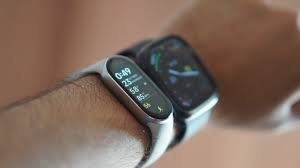In the ever-expanding world of smart wearables, two devices stand out for very different reasons. On one side is the Xiaomi Smart Band 9 Pro, a sleek and affordable fitness tracker that punches above its weight. On the other is the Apple Watch Series 10 GPS + Cellular, a premium smartwatch that blends cutting-edge health features with seamless connectivity. While they cater to different audiences, comparing them reveals how far wearable tech has come and what users can expect at both ends of the price spectrum.
Let’s dive into a detailed comparison of these two devices across design, display, health tracking, smart features, battery life, and overall value.
Design and Build Quality
The Xiaomi Smart Band 9 Pro is lightweight and minimalist, weighing just 24.5 grams and measuring 10.8mm thick. Its aluminum alloy frame with a matte sandblasted finish offers a refined look that resists fingerprints and feels smooth to the touch. Available in black, pink, and rose gold, it’s designed for comfort and style.
The Apple Watch Series 10, on the other hand, is a premium device with a choice of aluminum or titanium cases. It features a rectangular dial with curved edges, a digital crown with haptic feedback, and a side button for navigation. The build quality is exceptional, with sapphire crystal glass on titanium models and Ion-X glass on aluminum variants. It’s water-resistant up to 50 meters and dust-resistant with an IP6X rating.
Verdict: Apple wins on premium materials and craftsmanship, while Xiaomi offers a sleek and durable design at a fraction of the weight and cost.
Display and Interface
Xiaomi’s Smart Band 9 Pro boasts a 1.74-inch AMOLED display with a 336 x 480 resolution, 1200 nits peak brightness, and a 60Hz refresh rate. The ultra-narrow 2.2mm bezel and curved glass make it immersive and easy to navigate. Users can choose from a wide range of watch faces, including interactive pet designs and third-party options.
Apple Watch Series 10 features a Retina LTPO OLED display with up to 2000 nits brightness and always-on functionality. The 46mm variant offers a 416 x 496 resolution, delivering crisp visuals and smooth transitions. The edge-to-edge display enhances usability, and the interface is powered by watchOS 11, offering fluid navigation and deep customization.
Verdict: Apple’s display is brighter and more responsive, but Xiaomi’s screen is impressive for its price and size.
Health and Fitness Tracking
Xiaomi Smart Band 9 Pro includes 24/7 heart rate and SpO₂ monitoring, stress tracking, sleep analysis with sleep animal insights, and menstrual cycle tracking. It supports over 150 sports modes, including a Pro Running Mode that tracks stride ratio, ground contact time, and vertical amplitude. The GNSS chip improves positioning accuracy by 33 percent, and the built-in compass adds outdoor utility.
Apple Watch Series 10 takes health tracking to another level. It features an electrical heart sensor, third-generation optical heart sensor, blood oxygen sensor, ECG app, temperature sensor, and cycle tracking with retrospective ovulation estimates. It also includes fall detection, crash detection, and noise monitoring. The workout suite is extensive, covering everything from swimming and cycling to HIIT and yoga, with advanced metrics like stride length and power zones.
Verdict: Apple offers medical-grade sensors and deeper insights, while Xiaomi provides comprehensive tracking for fitness enthusiasts.
Smart Features and Connectivity
Xiaomi’s Smart Band 9 Pro supports voice assistance via Xiao Ai, offline payments, NFC for transit and car unlocking, and dual-device pairing. It includes over 20 third-party apps and offers basic notification handling. However, it lacks built-in cellular connectivity.
Apple Watch Series 10 GPS + Cellular supports LTE and UMTS, allowing users to make calls, send texts, and stream music without a phone. It includes Siri with on-device processing, international emergency calling, and support for Apple Pay. The watchOS ecosystem offers seamless integration with iPhone, AirPods, and other Apple devices.
Verdict: Apple dominates in smart features and standalone connectivity, while Xiaomi offers practical tools for daily convenience.
Battery Life and Charging
Xiaomi Smart Band 9 Pro delivers up to 21 days of battery life on typical usage, thanks to its 350mAh lithium-ion polymer battery. It charges via magnetic dock and supports fast charging.
Apple Watch Series 10 offers up to 18 hours of battery life during normal use and up to 36 hours in low power mode. It supports fast charging, reaching 80 percent in about 30 minutes.
Verdict: Xiaomi wins on endurance, while Apple offers faster charging and more power-hungry features.
Price and Value
The Xiaomi Smart Band 9 Pro is priced around ₹6,000, making it one of the most feature-rich fitness bands in its category. It’s ideal for users who want advanced tracking and smart features without spending a fortune.
The Apple Watch Series 10 GPS + Cellular starts at ₹56,900, reflecting its premium build, advanced sensors, and standalone capabilities. It’s best suited for users deeply embedded in the Apple ecosystem who want a smartwatch that does it all.
Verdict: Xiaomi offers unbeatable value, while Apple delivers a luxury experience with unmatched integration.
Final Thoughts
The Xiaomi Smart Band 9 Pro and Apple Watch Series 10 GPS + Cellular represent two different philosophies in wearable tech. Xiaomi focuses on delivering high-end features at an accessible price, while Apple aims to create a seamless, powerful experience for users who demand the best.
If you’re looking for a fitness tracker with excellent battery life, stylish design, and robust health features, the Smart Band 9 Pro is a smart choice. If you want a smartwatch that can replace your phone, track your health with medical-grade precision, and integrate flawlessly with your Apple devices, the Series 10 is worth the investment.
FAQ
Q: Can the Xiaomi Smart Band 9 Pro make calls?
A: No, it does not support cellular connectivity or calling features.
Q: Does the Apple Watch Series 10 work without an iPhone?
A: It requires an iPhone for setup and full functionality, but the GPS + Cellular model can operate independently for calls and data.
Q: Which device has better battery life?
A: The Xiaomi Smart Band 9 Pro offers up to 21 days, while the Apple Watch Series 10 provides up to 18 hours under normal use.
Q: Is the Xiaomi Smart Band 9 Pro suitable for swimming?
A: Yes, it has a 5ATM water resistance rating, making it suitable for pool workouts.
Q: Can I use third-party apps on both devices?
A: Apple Watch supports a wide range of third-party apps via the App Store. Xiaomi offers limited third-party app support through its companion app.
Q: Which is better for fitness tracking?
A: Both are excellent, but Apple offers more advanced metrics and medical-grade sensors, while Xiaomi covers a broader range of sports modes at a lower cost.
🆚 Xiaomi Smart Band 9 Pro vs Apple Watch Series 10 GPS + Cellular
| Feature | Xiaomi Smart Band 9 Pro | Apple Watch Series 10 GPS + Cellular |
|---|---|---|
| Display | 1.74″ AMOLED, 336×480, 1200 nits, 60Hz | 46mm LTPO OLED Retina, 416×496, 2000 nits |
| Build Material | Aluminum alloy frame | Aluminum or Titanium case |
| Weight | 24.5g | 35.3g |
| Water Resistance | 5ATM | 50m, IP6X dust resistance |
| Health Sensors | Heart rate, SpO₂, stress, sleep, menstrual | ECG, Blood Oxygen, Temp, Heart Rate, Fall Detection |
| Fitness Modes | 150+ sports modes, Pro Running Mode | Advanced workouts, stride length, power zones |
| GPS & Navigation | GNSS chip, compass | GPS, altimeter, international SOS |
| Smart Features | NFC, Xiao Ai voice assistant, dual pairing | Siri, Apple Pay, cellular calling, App Store |
| Battery Life | Up to 21 days | Up to 18 hours (36 hours in low power mode) |
| Charging | Magnetic fast charging | Fast charging (80% in ~30 mins) |
| OS & Ecosystem | HyperOS 2 | watchOS 11 |
| Price (approx.) | ₹6,000 | ₹56,900+ |
| Ideal For | Fitness-focused users on a budget | Premium users in Apple ecosystem |
🇮🇳 PlayStation vs Xbox: Indian Market Comparison
| Category | PlayStation (Sony) | Xbox (Microsoft) |
|---|---|---|
| Market Entry | Early (PS2 era) | Later (Xbox 360 era) |
| Brand Recognition | High, synonymous with console gaming | Moderate, niche appeal |
| Pricing Strategy | Tiered bundles, regional discounts | Global pricing, fewer India-specific offers |
| Exclusive Titles | God of War, Spider-Man, Horizon | Halo, Forza, Starfield |
| Subscription Model | PlayStation Plus | Xbox Game Pass |
| Retail Presence | Strong |



